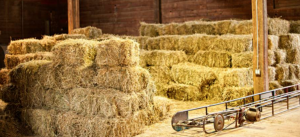 Who doesn’t love throwing their horses soft, fluffy hay?
Who doesn’t love throwing their horses soft, fluffy hay?
Experienced horse owners use their eyes, noses, and hands to help determine hay quality. Visually, the hay should be a pleasant color, ranging from deep green to light yellowish-green, and should be free of weeds, thorns, and other unwanted vegetation. Further, properly cured hay will smell fresh with no hint of mustiness or mold, which would indicate suspicious timing of harvest. The texture of hay also tells a tale, and together with visual and olfactory assessment, will help reveal its worth as a feedstuff.
Loosely speaking, hay texture can be split into four categories: very soft, standard, harsh, and extremely harsh.
Very soft:
The most desirable texture and usually indicative of well-cured early-maturity grass hay. “Very soft hay is characterized by fine, lithe stems that are nearly indistinguishable by feel from leaves,” said Catherine Whitehouse, M.S., a nutrition advisor with Kentucky Equine Research (KER). Hay of this texture might be particularly useful for horses with tender mouths, including those that have had extensive dental work, such as extractions, or those with a sore tongues or gums.
Standard:
Most hay probably falls into this category. “Leaves are generally soft, and stems are slightly stiff as lignification has begun. Stems remain easy to bend, though. Horses with normal molars will have absolutely no problem processing this forage,” said Whitehouse. Early-maturity, high-quality alfalfa often falls into this category, as do many good-quality grass hays.
Harsh:
This hay is characterized by its obvious stemminess, to the point that it is almost unpleasant to touch. The stems will be more rigid, as lignification has advanced, and fewer leaves might be present. Although all hay is “dry,” hay with a harsh texture will feel even more so, almost brittle. Sensitive horses might pick at this forage, eating slowly and cautiously. More waste will be noticed by managers, especially in group-feeding situations.
Extremely harsh:
This hay would represent the bottom of the barrel in terms of texture quality. “Inflexible stems typify this forage. Lignified structures have little nutritional value,” said Whitehouse. Ends of stems may be so pointed and sharp that mouth injuries occur. Intake might decline dramatically, and horses offered this forage for long periods will likely lose weight. Wastage will be at its peak with extremely harsh forage.
Although texture is important in hay selection, a host of factors determine what hay is best for any given horse, according to Whitehouse, and include stage of life, metabolism, and level of activity. Because hay provides the bulk of many well-balanced diets, its quality can have a significant impact on energy consumption as well as overall well-being.
Do you have a question about what type of hay will fit best into your horse’s feeding management? J and J Hay Farms can help! Contact us today.
Article brought to you by Kentucky Equine Research.
